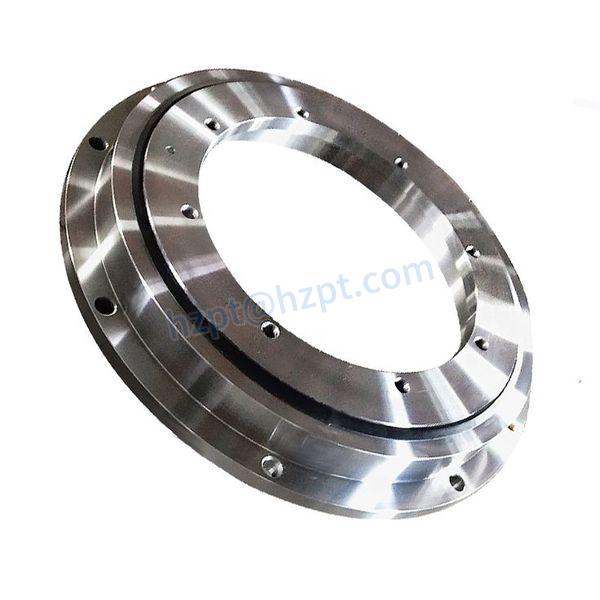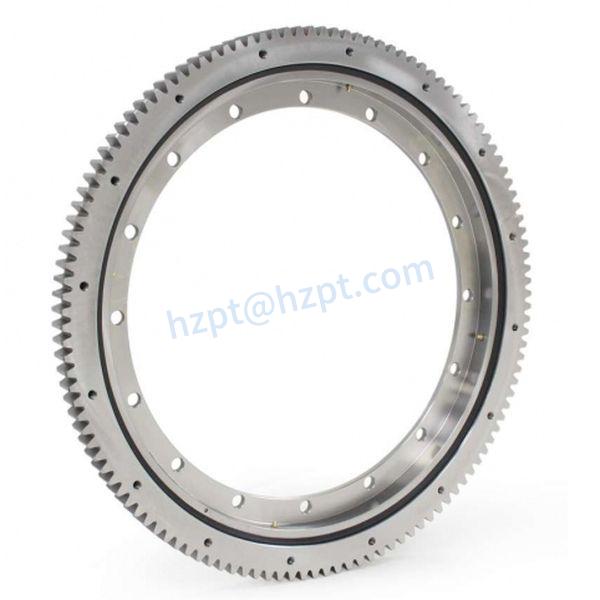Product Description
Product Description
Slewing Ring Bearing Definition:
Slewing bearings are large-sized bearings which can accommodate a combined load, i.e., radial loads and tilting moment. They are usually provided with holes for fixing bolts; internal, external or no gear; and lubrication holes and seals, which allow a compact and economical arrangement. In addition, they often enable the elimination of many components necessary in the classical bearing arrangement.
Slewing Ring Bearings are also called slewing rings, slewing bearings, slewing ring bearings, slewing gear, gear, turntable bearings and rotary bearing
Slew Ring Bing Specifications:
|
Product Name |
High Precision Slewing Bearing |
|
Material |
Chrome Steel |
|
Operating Temperature |
-40°C ~ +50°C |
|
Heat treatment |
Quenching and tempering, Raceway induction quenching |
|
Standard |
EN 15714 2.2; EN 15714 3.1.B ; EN15714 3.1.C |
|
Features |
Four Point Contact |
|
Application |
Crane, Excavator, all kinds of machine |
Slew Ring Bing Types:
1. 4 point contact ball slewing ring bearings
2. double row ball 4 point contact slewing ring bearings(same diameter ball; different diameter ball)
3. cross roller slewing ring bearings
4. triple row cylindrical roller combined slewing ring bearings
5. ball roller combined slewing ring bearings
6. light flanged slewing ring bearings
Slew Ring Bing Applications:
Slewing ring bearings are widely used in industry and known as “the machine joints” Hereunder is the specific slewing bearing applications
1. Construction machinery (e.g. cranes, excavators, loader, scraper)
2. Metallurgical machinery (e.g. for steel plant)
3. Heavy machinery equipments (e.g. mining machinery, concrete machinery)
4. Marine machinery equipment (e.g. vessel, port hoisting machine, port oil transfer equipment, onshore and offshore crane)
5. Light machinery equipments (e.g. paper machine, plastic, rubber machine, weave machine)
6. Wind power generator
7. Military products (e.g. aerospace machinery)
8. Packing machinery
Production Process of Slew Ring Bing:
Forging ring body material ⇒ Rough Lathing ⇒ Raceway heat treatment ⇒ Drilling ⇒ Teeth cutting ⇒ Teeth heat treatment ⇒ Ball hardness inspection ⇒ Assembling ⇒ Finall inspection ⇒ Packaging
Packaging & Shipping
Company Profile
Ruika Slewing bearing is established in 2004 with over 80 patents, FH mainly produce OEM slewing bearing, slew drive, pinion, FH has passed ISO9001-2005, SGS, CAPE etc, FH also accept the service durability test, resist fatigue test, anti-corrosion test and anti-terrible temperature test, which is widely used for Construction machinery, port, AI and new energy industries.
/* January 22, 2571 19:08:37 */!function(){function s(e,r){var a,o={};try{e&&e.split(“,”).forEach(function(e,t){e&&(a=e.match(/(.*?):(.*)$/))&&1
| Standard or Nonstandard: | Standard |
|---|---|
| Feature: | High Speed, Vacuum, Antimagnetic, Cold-Resistant, Corrosion-Resistant, Heat-Resistant |
| Sealing Gland: | Non-Seal |
| Rolling-Element Number: | Multiple-Column |
| Roller Type: | Deep Groove Raceway |
| Material: | Cast Iron |
| Samples: |
US$ 1000/Piece
1 Piece(Min.Order) | |
|---|
| Customization: |
Available
| Customized Request |
|---|
How do Slewing Bearings Contribute to the Smooth Rotation of Cranes and other Heavy Machinery?
Slewing bearings play a vital role in ensuring the smooth and efficient rotation of cranes and other heavy machinery that require controlled movement. Their design and functionality are specifically tailored to handle the unique challenges posed by such applications. Here’s how slewing bearings contribute to the smooth rotation of cranes and heavy machinery:
- Load Handling:
Crane operations involve lifting and moving heavy loads. Slewing bearings are designed to carry substantial axial, radial, and moment loads simultaneously. This load-handling capacity allows cranes to lift and transport heavy objects with precision.
- Smooth Rotation:
Slewing bearings provide a smooth interface between the upper structure (superstructure) and the lower structure (substructure) of the machinery. This allows for controlled and precise rotation of the upper structure, enabling cranes to maneuver smoothly during lifting, loading, and unloading operations.
- Efficient Torque Transmission:
During crane rotation, torque generated by the motor is transmitted through the slewing bearing to the upper structure. The bearing’s design ensures efficient torque transmission, minimizing energy losses and facilitating smooth rotation even under heavy loads.
- Low Friction and Wear:
Slewing bearings are engineered to minimize friction and wear. This reduces the energy required for rotation and prevents premature wear that could affect the bearing’s performance and longevity.
- High Stiffness:
Slewing bearings exhibit high stiffness, which contributes to the stability of the machinery during rotation. This stiffness ensures minimal deflection and maintains precise alignment, essential for safe and controlled movement.
- Uniform Load Distribution:
The raceway design of slewing bearings promotes uniform load distribution among rolling elements. This prevents stress concentrations and uneven wear, enhancing the bearing’s durability and contributing to smooth operation.
- Slow and Controlled Movement:
Crane operations often require slow and controlled rotation, especially when positioning heavy loads. Slewing bearings facilitate this type of movement, allowing operators to make precise adjustments.
- Customization for Specific Applications:
Slewing bearings can be customized to match the specific requirements of different crane designs and applications. This customization ensures optimal performance and longevity in various operational scenarios.
In summary, slewing bearings are essential components that enable the smooth and precise rotation of cranes and heavy machinery. Their load-carrying capacity, low friction, high stiffness, and ability to transmit torque efficiently contribute to the reliable and controlled movement required for various lifting and loading operations.
What are the Common Maintenance Practices for Ensuring the Durability of Slewing Bearings?
Maintaining slewing bearings is crucial for ensuring their longevity and optimal performance. Here are some common maintenance practices to enhance the durability of slewing bearings:
- Regular Inspection:
Perform routine visual inspections to check for signs of wear, corrosion, and damage. Inspect seals, lubrication levels, and any unusual noises or vibrations during operation.
- Lubrication:
Follow the manufacturer’s guidelines for lubrication intervals and use appropriate lubricants. Lubricate the bearings to ensure smooth operation, reduce friction, and prevent wear.
- Seal Maintenance:
Inspect and maintain seals to prevent the ingress of contaminants such as dust, dirt, and moisture. Damaged or worn seals should be replaced promptly.
- Cleaning:
Regularly clean the bearing and its surrounding area to remove dirt, debris, and contaminants that could affect performance. Keep the bearing environment as clean as possible.
- Environmental Protection:
If the bearings are exposed to harsh conditions, consider using protective covers or shields to prevent direct exposure to elements like water, chemicals, and abrasive materials.
- Alignment and Mounting:
Ensure proper alignment during installation to prevent unnecessary stress on the bearing. Accurate mounting reduces the risk of misalignment-related failures.
- Torque Monitoring:
If the bearing has gears, regularly monitor and maintain the torque levels to prevent overloading and premature wear.
- Load Distribution:
Operate the machinery within the specified load limits to avoid overloading the bearing, which can lead to fatigue and failure.
- Replacement of Worn Components:
If any components, such as seals or lubrication fittings, show signs of wear, replace them promptly to maintain the integrity of the bearing system.
- Documentation:
Maintain records of maintenance activities, including lubrication schedules, inspections, and any repairs or replacements. This documentation helps track the bearing’s history and aids in decision-making.
- Training:
Ensure that maintenance personnel are adequately trained to carry out proper inspection, lubrication, and maintenance procedures.
By implementing these maintenance practices, you can maximize the service life of slewing bearings, minimize downtime, and maintain consistent machinery performance.
What is a Slewing Bearing and How Does It Work?
A slewing bearing, also known as a turntable bearing, is a specialized type of rolling-element bearing designed to handle axial, radial, and moment loads simultaneously. It allows rotational movement between two parts while supporting the loads applied to them. Slewing bearings are commonly used in various applications such as cranes, construction equipment, wind turbines, and industrial machinery.
At its core, a slewing bearing consists of multiple components, including an outer ring, an inner ring, rolling elements (balls or rollers), and in some designs, a gear or teeth arrangement. The outer ring is typically stationary and mounted to a fixed structure, while the inner ring is connected to the rotating part. The rolling elements provide smooth movement between the two rings, enabling rotation.
Slewing bearings work by minimizing friction and distributing loads effectively across the rolling elements. When a rotational force is applied to the inner ring, the rolling elements facilitate the smooth rotation of the inner ring relative to the outer ring. The rolling elements are positioned within raceways or grooves in the rings, ensuring proper contact and load distribution.
The addition of gears or teeth to the slewing bearing design enables the transmission of torque between the inner and outer rings. This feature is particularly useful when precise rotation control is required, as seen in applications like cranes and heavy machinery.
In summary, a slewing bearing functions as a rotational joint that can support various loads and movements. Its design, which includes rolling elements and optional gear systems, allows it to manage axial, radial, and moment loads while facilitating smooth rotation between connected parts.
editor by CX 2024-04-12




